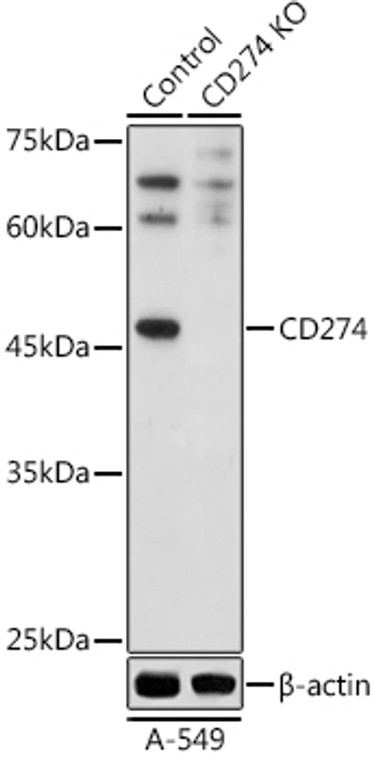| Host: |
Rabbit |
| Applications: |
WB |
| Reactivity: |
Human/Mouse/Rat |
| Note: |
STRICTLY FOR FURTHER SCIENTIFIC RESEARCH USE ONLY (RUO). MUST NOT TO BE USED IN DIAGNOSTIC OR THERAPEUTIC APPLICATIONS. |
| Short Description: |
Rabbit polyclonal antibody anti-CD274 (19-239) is suitable for use in Western Blot research applications. |
| Clonality: |
Polyclonal |
| Conjugation: |
Unconjugated |
| Isotype: |
IgG |
| Formulation: |
PBS with 0.05% Proclin300, 50% Glycerol, pH7.3. |
| Purification: |
Affinity purification |
| Dilution Range: |
WB 1:100-1:500 |
| Storage Instruction: |
Store at-20°C for up to 1 year from the date of receipt, and avoid repeat freeze-thaw cycles. |
| Gene Symbol: |
Cd274 |
| Gene ID: |
60533 |
| Uniprot ID: |
PD1L1_MOUSE |
| Immunogen Region: |
19-239 |
| Immunogen: |
Recombinant fusion protein containing a sequence corresponding to amino acids 19-239 of mouse CD274 (NP_068693.1). |
| Immunogen Sequence: |
FTITAPKDLYVVEYGSNVTM ECRFPVERELDLLALVVYWE KEDEQVIQFVAGEEDLKPQH SNFRGRASLPKDQLLKGNAA LQITDVKLQDAGVYCCIISY GGADYKRITLKVNAPYRKIN QRISVDPATSEHELICQAEG YPEAEVIWTNSDHQPVSGKR SVTTSRTEGMLLNVTSSLRV NATANDVFYCTFWRSQPGQN HTAELIIPELPATHPPQNRT H |
| Tissue Specificity | Highly expressed in the heart, thymus, skeletal muscle, and lung. Weakly expressed in the kidney, spleen, thyroid, and liver. Expressed on activated dendritic cells, B-cells and macrophages. Expressed in numerous tumor cells lines of lymphoid origin. |
| Post Translational Modifications | Ubiquitinated.STUB1 likely mediates polyubiquitination of PD-L1/CD274 triggering its degradation. Ubiquitinated by MARCHF8.leading to degradation. |
| Function | Plays a critical role in induction and maintenance of immune tolerance to self. As a ligand for the inhibitory receptor PDCD1/PD-1, modulates the activation threshold of T-cells and limits T-cell effector response. Through a yet unknown activating receptor, may costimulate T-cell subsets that predominantly produce interleukin-10 (IL10). The PDCD1-mediated inhibitory pathway is exploited by tumors to attenuate anti-tumor immunity and escape destruction by the immune system, thereby facilitating tumor survival. The interaction with PDCD1/PD-1 inhibits cytotoxic T lymphocytes (CTLs) effector function. The blockage of the PDCD1-mediated pathway results in the reversal of the exhausted T-cell phenotype and the normalization of the anti-tumor response, providing a rationale for cancer immunotherapy. |
| Protein Name | Programmed Cell Death 1 Ligand 1Pd-L1Pdcd1 Ligand 1Programmed Death Ligand 1B7 Homolog 1B7-H1Cd Antigen Cd274 |
| Database Links | Reactome: R-MMU-389948 |
| Cellular Localisation | Cell MembraneSingle-Pass Type I Membrane ProteinEarly Endosome MembraneRecycling Endosome Membrane |
| Alternative Antibody Names | Anti-Programmed Cell Death 1 Ligand 1 antibodyAnti-Pd-L1 antibodyAnti-Pdcd1 Ligand 1 antibodyAnti-Programmed Death Ligand 1 antibodyAnti-B7 Homolog 1 antibodyAnti-B7-H1 antibodyAnti-Cd Antigen Cd274 antibodyAnti-Cd274 antibodyAnti-B7h1 antibodyAnti-Pdcd1l1 antibodyAnti-Pdcd1lg1 antibodyAnti-Pdl1 antibody |
Information sourced from Uniprot.org
12 months for antibodies. 6 months for ELISA Kits. Please see website T&Cs for further guidance








